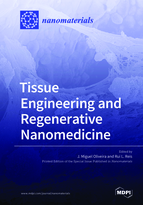Tissue Engineering and Regenerative Nanomedicine
A special issue of Nanomaterials (ISSN 2079-4991).
Deadline for manuscript submissions: closed (31 May 2018) | Viewed by 38619
Special Issue Editors
Interests: nanobiomaterials; nanomedicine; theranostics; tissue engineering; 3D printing; 3D in vitro tissue models of disease
Interests: natural origin materials; marine-derived materials; biomaterials processing; porous scaffolds; tissue engineering; regenerative medicine; stem cells; biomimetics; biodegradables; drug delivery; nanotechnology; polymer chemistry; bioceramics; microfluidics; 3D in-vitro cancer models; biodegradable urological stents
Special Issues, Collections and Topics in MDPI journals
Special Issue Information
Dear Colleagues,
The convergence of the regenerative principles in Nanomedicine and Tissue Engineering promise to create new avenues in Regenerative Medicine. It is now recognized the great advantages of using nanomaterials for controlled drug delivery, scaffolding, sensing and imaging applications. Emerging engineering strategies possibly synthesizing nanosystems with different compositions and architectures. Multi-modal nanomaterials are now being designed by means of incorporating different stimuli-responsive functionalities, peptides, antibodies and imaging probes towards targeting specific cells, tissues and organs while offering the possibility to track its fate in real-time.
This Special Issue focus on the most recent advances related to the design of different nanobiomaterials, functionalization strategies, processing methods, biological performance assessment and safety, and its applications for theranostics of cancer, musculoskeletal and neurodegenerative diseases/disorders.
Submissions can cover the following topics (but are not limited to them):
· Design, synthesis and functionalization of nanobiomaterials
· Formulation and processing of nanomaterials
· Strategies combining nanoparticles and emerging technologies (e.g. microfluidics)
· Pre-clinical characterization of nanomaterials
· Nanoparticles for imaging and diagnosis
· Applications of nanomaterials in theranostics of cancer, musculoskeletal and neurodegenerative diseases/disorders.
Prof. Dr. Joaquim Miguel Oliveira
Prof. Dr. Rui L. Reis
Guest Editors
Manuscript Submission Information
Manuscripts should be submitted online at www.mdpi.com by registering and logging in to this website. Once you are registered, click here to go to the submission form. Manuscripts can be submitted until the deadline. All submissions that pass pre-check are peer-reviewed. Accepted papers will be published continuously in the journal (as soon as accepted) and will be listed together on the special issue website. Research articles, review articles as well as short communications are invited. For planned papers, a title and short abstract (about 100 words) can be sent to the Editorial Office for announcement on this website.
Submitted manuscripts should not have been published previously, nor be under consideration for publication elsewhere (except conference proceedings papers). All manuscripts are thoroughly refereed through a single-blind peer-review process. A guide for authors and other relevant information for submission of manuscripts is available on the Instructions for Authors page. Nanomaterials is an international peer-reviewed open access semimonthly journal published by MDPI.
Please visit the Instructions for Authors page before submitting a manuscript. The Article Processing Charge (APC) for publication in this open access journal is 2900 CHF (Swiss Francs). Submitted papers should be well formatted and use good English. Authors may use MDPI's English editing service prior to publication or during author revisions.
Keywords
- Cancer
- Imaging
- Musculoskeletal
- Nanobiomaterials
- Neurosciences
- Processing methods
- Nanomedicine
- Tissue engineering








